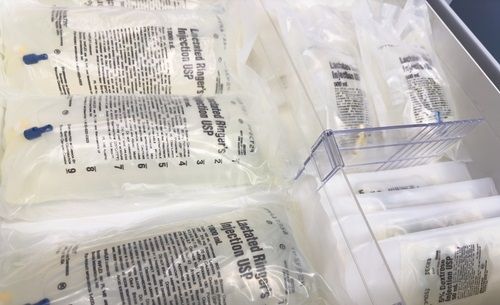
From daily challenges like shortages of IV solutions to bigger picture items like cybersecurity concerns and artificial intelligence, IDNs tackled an ever-changing landscape this year. Here are three challenges they faced and how they are forging the future.
1. Natural disasters and the shortage of IV solutions
Hurricane Helene was a devastating tropical cyclone that caused widespread catastrophic damage and numerous fatalities across the Southeast in late September.
The storm caused flooding particularly in North Carolina, Tennessee and Virginia, and Baxter International, which produces 60% of the IV solutions for U.S. hospitals, saw its North Cove, N.C., facility affected and closed for production. More than 86% of providers experienced shortages of IV solutions in the aftermath, according to Premier, and some elective surgeries were canceled or delayed.
In recent years, hospitals have made significant investments in resiliency, and some had IV solutions in stock at distribution facilities managed closely by inventory planning teams. Baxter imported shipments of IV solutions from two international facilities in October and continually worked to bring its North Carolina facility back online.
Two IV solutions manufacturing lines restarted in November, producing about 85% of the site’s pre-hurricane capacity of 1-liter IV solutions, the most commonly used size by hospitals and clinics. It released the first product manufactured post-hurricane the week of Nov. 18.
Conservation efforts for IV solutions across the healthcare industry remain essential to supplement allocation levels and preserve supply.
2. IT outages and cybersecurity threats
On July 19, cybersecurity company CrowdStrike distributed a faulty update to its Falcon Sensor security software that caused widespread problems with Microsoft Windows computers running the software. Roughly 8.5 million systems crashed and were unable to properly restart.
It was called the largest outage in the history of IT, affecting airlines, airports, banks, hotels, hospitals, manufacturing, stock markets, broadcasting, gas stations, retail stores and more. The AHA heard from hospitals and health systems that impacts varied widely.
Some hospitals experienced little to no impact while others dealt directly with some disruptions to medical technology, communications and third-party service providers. This resulted in some clinical procedure delays, diversions or cancellations.
The healthcare industry is estimated to have suffered direct losses of $1.94 billion with an average estimated loss of $64.6 million per company, according to The HIPAA Journal. Healthcare and banking absorbed more than half of the total financial losses caused by the outage.
Modern healthcare IT infrastructures are interconnected, meaning a single point of failure can have large consequences. The CrowdStrike outage affected multiple companies that hospitals rely on and it’s a reminder that technology resiliency is essential. Comprehensive disaster recovery, business continuity and communications plans are fundamental.
Over 99% of Windows sensors were back online 10 days later on July 29.
3. The rise of AI and machine learning
There are projections that AI in healthcare will become a $188 billion industry worldwide by 2030, and hospitals are increasingly leveraging AI to enhance their systems and operations. These machine learning predictors help target patient needs, manage supply efficiently and identify trends in resource utilization on a grander scale.
CB Insights’ Hospital AI Readiness Index measures two key pillars – innovation and execution – across the healthcare landscape as to how health systems are prepared to adapt to an evolving AI environment. The scorecard is tabulated on a health system’s track record of developing or acquiring novel AI capabilities and its ability to bring AI-powered products and services into clinical practice.
The top three ranked hospitals for AI innovation are Mayo Clinic, Intermountain Health and Cleveland Clinic.
Mayo was cited for having filed more than 50 patents for AI-enabled tools in cardiology, oncology and elsewhere, and having invested in AI startups. Intermountain and Cleveland were recognized for development of an automated clinical decision support system and productive AI-based business relationships.
Today, AI and machine learning are being used in real life settings and there’s a chance a computer can read an MRI or X-ray better than a human, according to Rohit Chandra, chief digital officer at Cleveland Clinic.
The IDN Directory provides insights into the supply chains for the biggest health systems in the country to give manufacturer reps, distribution reps, and national accounts managers a quick, accurate view of what’s going on with their customers - right now. Contact us at demo@idndirectory.com to schedule a demo today!
